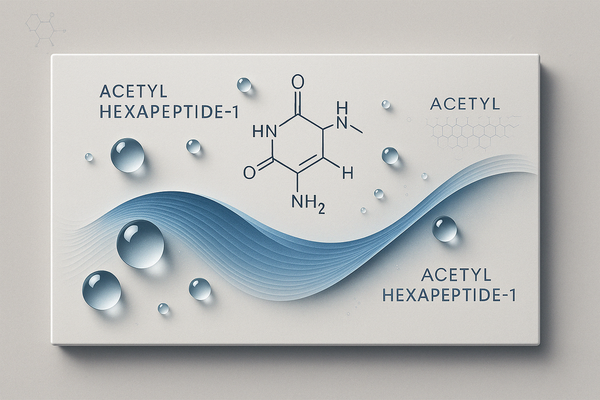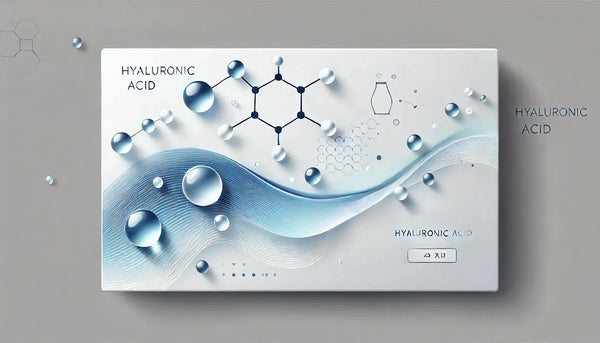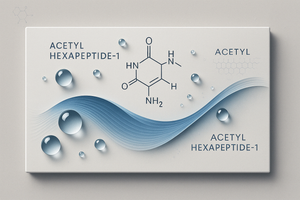Introduction
The hyaluronic acid ("HA") is a fundamental molecule of the extracellular matrix (ECM), widely studied for its role in skin hydration, wound healing, and inflammation modulation.
In recent decades, research has highlighted the differences between the various forms of hyaluronic acid, particularly between high molecular weight (HMW-HA, High Molecular Weight Hyaluronic Acid) and low molecular weight (LMW-HA, Low Molecular Weight Hyaluronic Acid). In this article, we analyze high molecular weight hyaluronic acid, exploring its characteristics, benefits, and the scientific support that demonstrates its effectiveness.
Chemical Structure and Function of Hyaluronic Acid
Hyaluronic acid is a glycosaminoglycan (GAG) composed of repetitions of disaccharide units of glucuronic acid and N-acetylglucosamine. Its ability to bind and retain large amounts of water makes it essential for maintaining skin hydration and structure.
Hyaluronic acid comes in varying molecular weights, which influence its biological properties:
- HMW-HA (> 1000 kDa): moisturizing, protective, and anti-inflammatory properties.
- LMW-HA (< 500 kDa): better skin penetration, stimulation of cell regeneration, but potentially pro-inflammatory.
The molecular weight is a critical factor in the selection of hyaluronic acid in cosmetic and pharmaceutical formulations.
Benefits of High Molecular Weight Hyaluronic Acid
1. Hydration and Skin Protection
HMW-HA is particularly effective in retaining water in the superficial layers of the skin, creating a protective film that reduces transepidermal water loss (TEWL - Transepidermal Water Loss).
Scientific evidence:
- A study published in Journal of Clinical and Aesthetic Dermatology (2011) demonstrated that the topical application of HMW-HA increases skin hydration by up to 96% after 8 weeks.
- Another study published in Dermato-Endocrinology (2012) confirmed that hyaluronic acid with a molecular weight greater than 1000 kDa significantly improves skin barrier function.
2. Anti-Inflammatory and Soothing Effect
HMW-HA has an anti-inflammatory action, reducing the production of pro-inflammatory cytokines such as IL-1β and TNF-α, often involved in conditions like atopic dermatitis, psoriasis, and rosacea.
Scientific evidence:
- A study published in International Journal of Molecular Sciences (2020) highlighted that high molecular weight hyaluronic acid significantly reduces oxidative stress and skin inflammation.
- According to a study published in The Journal of Allergy and Clinical Immunology (2018), the use of high molecular weight HA on skin affected by atopic dermatitis resulted in a 35% reduction in itching and an improvement in the skin barrier.
3. Role in Wound Healing
HMW-HA plays an essential role in the processes of wound healing and tissue repair, stimulating fibroblast proliferation and improving re-epithelialization.
Scientific evidence:
- A review published in Biomolecules (2021) indicated that high molecular weight HA promotes the healing of chronic wounds by reducing inflammation and improving the formation of new blood vessels (angiogenesis).
- A clinical trial published in Wound Repair and Regeneration (2019) demonstrated that the application of HMW-HA on diabetic ulcers accelerated healing by 45% in less than 12 weeks.
4. Protection from Environmental Damage and Skin Aging
High molecular weight hyaluronic acid creates a protective barrier on the skin, reducing exposure to free radicals, pollution, and UV rays.
Scientific evidence:
- According to a study published in Skin Pharmacology and Physiology (2018), HMW-HA reduces UV-induced lipid peroxidation by 60%.
- A study from the Journal of Drugs in Dermatology (2020) confirmed that the regular use of high molecular weight hyaluronic acid helps to reduce wrinkle depth by 40% after three months of application.
Applications of High Molecular Weight Hyaluronic Acid
1. Cosmetics and Skincare
- Moisturizing formulations for dry and sensitive skin.
- Treatments for reactive skin and dermatitis.
- Anti-pollution and anti-aging serums.
2. Clinical Dermatology and Aesthetic Medicine
- Treatment of burns and surgical wounds.
- Support in the treatment of atopic dermatitis and psoriasis.
- Post-peeling and post-laser use to reduce irritation.
3. Ophthalmology
- Artificial tears for dry eyes and dry eye syndrome.
- Protection of the cornea in ophthalmic surgeries.
4. Orthopedics and Rheumatology
- Intra-articular infiltrations for the treatment of osteoarthritis.
- Reduction of joint pain and improvement of mobility.
Conclusion
High molecular weight hyaluronic acid is an extremely versatile molecule, with documented benefits in dermatological, aesthetic, and medical fields. Scientific evidence confirms its effectiveness as a moisturizing, protective, and soothing agent, demonstrating great potential for skin and joint health.
"Thanks to its ability to retain water, modulate inflammation, and protect against environmental damage, HMW-HA proves to be a key ingredient in advanced cosmetic formulations and regenerative medical therapies."
Sources and Studies Cited
- Journal of Clinical and Aesthetic Dermatology (2011).
- International Journal of Molecular Sciences (2020).
- The Journal of Allergy and Clinical Immunology (2018).
- Wound Repair and Regeneration (2019).
- Skin Pharmacology and Physiology (2018).
- Journal of Drugs in Dermatology (2020).
"For more information and products with high molecular weight hyaluronic acid, visit LeLang Skincare."







